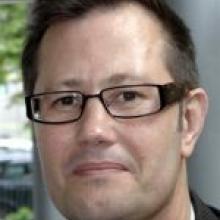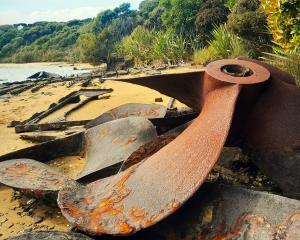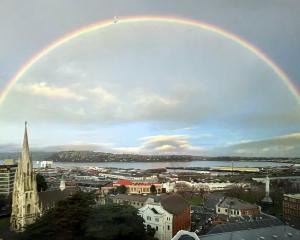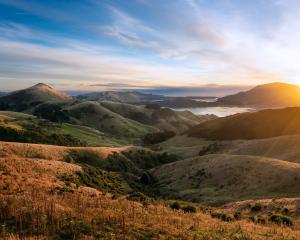
National gives the credit to its candidate and its campaigning. Labour blames a low turnout and national trends.
For weeks to come, the question of why the Dunedin South party vote turned from red to blue will be central to each party's after-match analysis.
They will study the electorate, polling place by polling place - trying to decipher from the bare numbers the motivation of voters.
And, each polling place has its own story to tell.
Here, for instance, is the one from a small polling place in the "blue-collar" heart of South Dunedin.
In 2008, 334 people voted at the St Patrick's Parish Centre in Macandrew Rd, and 190 of them gave their vote to Labour.
That was a comfortable 118 votes ahead of National.
Helen Clark was prime minister then, John Key was the new boy on the block and Clare Curran was, as she is now, the Labour member of Parliament for Dunedin South.
This time, 72 fewer people voted.
Labour's total vote was now 118.
That was 72 fewer than at the last election.
National [67] gained five votes, the Greens [34] gained 14 and New Zealand First [30] gained eight, while Act [two] lost nine.
In the end, Labour held sway at St Patrick's.
The polling-place stories beyond South Dunedin showed stronger forces at work, pushing Labour into second and even third place.

The electorate stretches from the affluent harbourside villages of Otago Peninsula, across the poorer areas of South Dunedin and off into the rural heartland of Middlemarch.
Dr Edwards noted Labour had focused its attention on South Dunedin and that allowed National to "hoover" up votes in the more affluent parts of the electorate such as Mosgiel, Abbotsford and Fairfield.
And, like many other electorates, Labour had missed the vote of what former Dunedin political commentator Chris Trotter defined as "Waitakere Man".
Trotter, after the last election, described a voter who had a trade certificate rather than a degree, worked hard to pay the mortgage and had no time for intellectuals, "politically-correct bull****" or welfare beneficiaries.
While the final numbers for individual polling stations won't be confirmed until next week, it is believed they will not change markedly from the preliminary party vote results already available.
The following summaries are compiled from the 59 Dunedin South polling places at this election and the 64 polling places at the 2008 elections.
ABBOTSFORD
Abbotsford changed colour - from red to a bluey-green - with something of a landslide of votes from the Labour camp into the National and Green camps.
Labour secured the votes of 378 Abbotsford voters - a drop of 206 from the 2008 election.
National gained 125 votes, to 393, and the Greens 37, to 90.
Act New Zealand was down 20, to six.
The turnout was down 154, to 982.
• National: by a nose.
Edwards: This suburb is becoming more conservative. It is an area of increasing affluence, and it now rates as three out of 10 on the University of Otago Index of Deprivation scale - a relatively wealthy suburb.
ANDERSONS BAY
Interest in the election appeared to slip at Andersons Bay - the number of votes cast down by 112, to 1318.
National took the suburb from Labour - its vote up 34, to 560, while Labour's was down 181 to 428.
The Greens collected an extra 69 votes, taking them to 223, but of the 36 Act voters at the last election, all but seven disappeared.
The biggest percentage jump was for the Aotearoa Legalise Cannabis Party, which went from no votes in the last election to two this time.
• National: by a head.
Edwards: It should be no surprise that this suburb shifted from red to blue. It rates as two out of 10 on the deprivation scale, making it a wealthy suburb.
BRIGHTON
Brighton almost changed allegiance.
However, even though Labour got 40 votes fewer than the last election and National gained six, Labour, with 169 votes, remained 12 ahead of National, on 157.
The biggest gain was made by the Greens, up 34, to 79, while the New Zealand First vote was up 13 to 33.
• Labour: by a short nose.
Edwards: The most interesting change in Brighton was the significant increase in Green voters. There are increasing number of middle-income and lifestyle residents - the type of voters that the Green Party is increasingly focused on. Brighton is five out of 10 on the deprivation scale - an averagely wealthy suburb.
CAVERSHAM
Two of the "minor" parties got the thumbs up at the two Caversham booths.
The Greens were up 93 votes, to 197, and New Zealand First almost doubled its score - up 51 to 119.
Labour held sway, however, with 543 votes, down 171 on the last election, and National was down one vote, at 308.
Act dropped 16, to 13.
• Labour: by a length and a-half.
Edwards: Caversham is a very poor suburb. It rates as eight out of 10 on the deprivation scale. So it should be no surprise that Caversham voters largely vote for Labour. But what is surprising is the significant increases for the Greens and New Zealand First.
CORSTORPHINE
Neither Labour nor National did well in Corstorphine - Labour losing 190 votes to end up on 389, and National losing 30 to take 235 votes.
And Act was down six to just one vote.
Only the Greens showed much upside - up 36, to 123.
The turnout was down 160, to 844.
• Labour: by half a head.
FAIRFIELD
Labour took a big hit at the Fairfield Community Hall, its vote plummeting by 197, to 380, while National picked up 75 votes to give it 718.
New Zealand First also did well with 93 votes - 56 more than last time - and the Greens were up by 67 votes, to 139.
Just eight Act voters remain from the 39 who voted that way the previous election.
• National: galloped home.
Edwards: It should be no surprise that National received twice the votes of Labour in Fairfield. This suburb is very wealthy, with a rating of one out of 10 on the deprivation scale.
GREEN ISLAND
Voters at the two Green Island booths bucked the low turnout trend with an extra 172 casting a valid party vote to make the total 1783.
Labour held the suburb with 729 votes, down 90 on last time, while National had a healthy gain of 177, to 637.
The Greens had a 71-vote gain, to 160, and New Zealand First was up 58 to 171. Act was back 26, to 14.
• Labour: by a head.
Edwards: Green Island is a typical "middle New Zealand" battleground for Labour and National. It rates as six out of 10 on the deprivation scale, meaning that it's an average, but slightly poor, suburb. As with similar suburbs around the country, Green Island swung towards National, although it still gives a greater proportion of its votes to Labour. National will be very pleased with this result.
MACANDREW BAY
At the Macandrew Bay School, National rolled Labour, with the help of the Greens.
National lifted its vote by 42, to 256, which was 30 ahead of Labour, which was down by 87 votes, to 226.
At the previous election, Labour was 99 votes ahead of National.
But even worse for Labour; it was beaten into third place by the Greens who increased their vote by 77, to 234.
• National: by a head.
Edwards: There will be some surprise to see Macandrew Bay won by National for the first time, but it is actually a very wealthy suburb. It rates as one out of 10 on the deprivation scale, making it one of the wealthiest in the country. This explains why the Greens, too, were able to push Labour into third place. Macandrew Bay is exactly the sort of area that the Green Party has been focused on winning new votes.
MIDDLEMARCH
The Strath Taieri School vote was interesting mainly because National lost [a little] ground in this traditionally blue ribbon area.
At the last election, National received 137 of the 213 votes cast.
This time they received 131 of 200 votes cast.
New Zealand First made the biggest gain, going from four to 14, while the Greens gained seven to make 18.
Labour went down 11, to 23.
• National: By the length of the back straight.
Edwards: Although Middlemarch might be considered a "traditionally blue-ribbon area", it is actually a relatively poor area. It rates as seven out of 10 on the deprivation scale, making it a relatively low socio-economic area. So although it is very much a National voting area due to its agricultural base, there might not be quite as much enthusiasm for the incumbents as might be expected.
MOSGIEL
There were 1571 fewer voters in Mosgiel than at the last election - the total valid party vote dropping to 4583 at the town's eight booths.
Labour suffered most of the consequences, conceding its top spot in the Mosgiel polls to National.
The Labour vote totalled 1501, 677 votes behind National.
At the previous election, Labour led National by 270.
The difference between Labour this time and last time was 1211.
Act was also harshly dealt with - its vote dropping 117, to 26.
• National: Bolted home.
Edwards: Mosgiel was obviously a disaster for Labour in 2011. Labour normally wins the town easily. Certainly it contains a spread of average-to-low socio-economic residents, according to the deprivation scale. Mosgiel South has a rating of five out of 10 and Mosgiel East has a rating of seven out of 10. Labour should easily win such an area. However, National's candidate, Joanne Hayes, lives in Mosgiel and focused much of her energy on winning over this area. Meanwhile, Labour's Clare Curran mostly focused her campaign attention on the general South Dunedin area.
MUSSELBURGH
Musselburgh voters gave the Greens the big thumbs up - handing them 61 votes more than last time, boosting their tally to 151.
That, combined with a Labour drop of 178, to 348, helped National ease into the lead with 369 votes - just four more than it got at the last election.
Musselburgh voters slashed their support for Act from 22 to five but there was no rush to New Zealand First, which gained just four votes to make 58.
• National: half a head.
OCEAN VIEW
The 391 people who voted at the Ocean View Public Hall swung towards National, giving it 149 votes, 13 ahead of Labour.
At the last election, Labour was 75 ahead of National.
The Green Party almost doubled its vote, up 29 to 60 while Act, which received 13 votes last time, sank to just one.
• National: a long nose.
OUTRAM
Voters at the Outram School turned an even deeper shade of blue.
Last election, National took 376 of the 655 votes cast, and Labour 188.
This time, National took 411 of 636 votes cast, and Labour 105.
The 21 Act supporters at the last election dwindled to two, while the Greens gained 25 to reach 58.
New Zealand First doubled its vote to 30.
• National: By a country mile.
PORTOBELLO
At Portobello, the turnout, at 440, was almost identical to 2008.
But, far from the substantial lead of 129 it held in 2008, Labour [130] finished third behind both National [138] and the Greens [132].
Act got 12 votes last time and none this time.
SOUTH DUNEDIN
The six booths of South Dunedin gave Labour 1336 votes and National 843. But, the vote for Labour was 466 less than at the last election while National was up 93.
The Green vote went up by 144, to 362, and the New Zealand First vote went up by 78, to 226.
Act got 53 votes last time and 14 this time.
The turnout, at 3115, was down 229.
• Labour: An easy run home.
Edwards: Although Labour won South Dunedin easily, the gap between Labour and National was surprisingly close for such a poor area, and this gap is considerably narrower than ever before. The South Dunedin area is rated 10 out of 10 on the deprivation scale - meaning that it is a very poor suburb.
ST CLAIR
Voters at the two St Clair booths changed sides, opting for National - 617 votes - over Labour - 408 votes.
At the last election, Labour got 558 votes and National 444.
The Greens gained 77 votes, for a total of 213, and New Zealand First went up 39, to 95.
Act's vote was cut by 19, to nine.
The turnout was down 117, to 1384.
• National: By a length.
ST KILDA
Labour hung on at the two St Kilda booths - collecting 293 votes compared to National's 219 - but it was down 84 votes on the last election.
National gained 52 votes, New Zealand First gained 39 votes, to 79, and the Greens went up 42 votes, to 91.
The turnout dropped by 50, to 716.
• Labour: By a long neck.
WAVERLEY
National tightened its grip on the windy knoll of Waverley, taking 772 votes, an increase of 59 on the last election.
Labour was left with 376 votes after dropping 214 votes from last time.
The Greens gained 101 votes to post 220 and New Zealand First was up 14, to 66. Act, however, was reduced by 42, to 16.
• National: At a canter.
~ THE VOTE ~
Dunedin South [35,569 votes counted]
Official party count:
• National 14,163
• Labour 12,326
• Green 4798
• New Zealand First 2522
• Conservative 520
• Informal 318
• Act New Zealand 210
• United Future 186
• Aotearoa Legalise Cannabis 157
• Democrats for Social Credit 126
• Maori 107
• Mana 62
• Alliance 58
• Libertarianz 16
Official candidate count:
• Clare Curran, Labour 16,844
• Joanne Hayes, National 12,669
• Shane Gallagher, Green 3197
• Randall Ratana, NZ First 979
• Warren Voight, Democrats for Social Credit 238
• Kimberly Hannah, Act 215
• Kay Murray, Alliance 142
• Robert Wansink, Restore All Things In Christ 167











